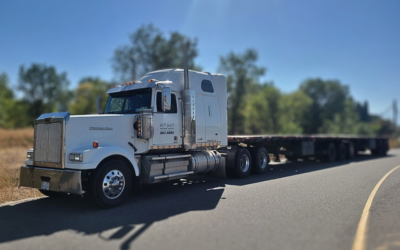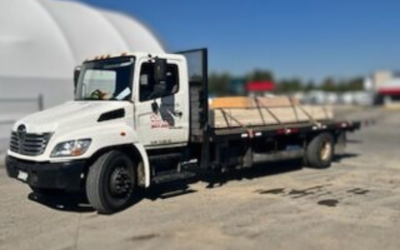In the dynamic world of logistics, selecting the right type of truck for shipping is crucial. It ensures the safe and efficient transport of goods. Among the options, flat deck, curtain side, tridem, and gooseneck trucks stand out as popular choices. Each type offers unique advantages tailored to specific cargo requirements. This article explores the benefits of these trucks. It also provides insights into why you might choose one over the other.
Flat Deck Trucks:
 Flat deck trucks, also known as flatbed trucks, are versatile workhorses. Their open, flat surface provides ample space for loading and securing various types of cargo. Flat deck trucks are adaptable to oversized or irregularly shaped freight. This includes machinery, construction materials, and large equipment. This is one of their primary benefits.
Flat deck trucks, also known as flatbed trucks, are versatile workhorses. Their open, flat surface provides ample space for loading and securing various types of cargo. Flat deck trucks are adaptable to oversized or irregularly shaped freight. This includes machinery, construction materials, and large equipment. This is one of their primary benefits.
Flat deck trucks have an open design. This makes loading and unloading easy and reduces turnaround times. Additionally, these trucks are ideal for transporting goods that require crane or forklift access. They enhance efficiency in the logistics process. Flat deck trucks are a preferred choice for industries with diverse shipping needs. They are simple and accessible.
Curtain Side Trucks:
 Curtain side trucks combine the flexibility of flat decks. They also add security and protection with enclosed trailers. These trucks have a retractable curtain on each side. This allows for quick and convenient access to the cargo. The curtain provides protection against the elements. Curtain side trucks are suitable for a wide range of goods. They include those sensitive to weather conditions.
Curtain side trucks combine the flexibility of flat decks. They also add security and protection with enclosed trailers. These trucks have a retractable curtain on each side. This allows for quick and convenient access to the cargo. The curtain provides protection against the elements. Curtain side trucks are suitable for a wide range of goods. They include those sensitive to weather conditions.
Curtain side trucks are versatile. They are an excellent choice for shippers dealing with diverse loads. The curtain side design ensures efficient loading and unloading. It safeguards cargo from external elements. It works for palletized goods, machinery, and retail merchandise. This makes curtain-side trucks an optimal choice for transporting goods. They demand a balance between accessibility and protection.
Tridem Trucks:
 Tridem trucks have an extra rear axle. They offer better stability and weight distribution. The third axle allows for higher weight capacities. Tridem trucks are suitable for hauling heavy loads over longer distances. The improved weight distribution also reduces wear on the truck’s components. This contributes to a longer lifespan and lower maintenance costs.
Tridem trucks have an extra rear axle. They offer better stability and weight distribution. The third axle allows for higher weight capacities. Tridem trucks are suitable for hauling heavy loads over longer distances. The improved weight distribution also reduces wear on the truck’s components. This contributes to a longer lifespan and lower maintenance costs.
Shippers often choose tridem trucks when dealing with heavy, bulk cargo. This is because tridem trucks have enhanced load-bearing capabilities. Tridem trucks provide a reliable solution for transporting substantial loads. They maintain safety and comply with weight regulations. They do this when transporting construction materials, industrial equipment, or raw materials.
Gooseneck Trucks:
 Gooseneck trucks have a front extension, or “gooseneck.” It connects to the towing vehicle. They offer unique advantages in maneuverability and accessibility. These trucks are commonly used for transporting specialized cargo. Examples include livestock trailers, RVs, and construction equipment. The gooseneck design allows for tighter turns and better control. This makes them suitable for navigating through challenging terrains or confined spaces.
Gooseneck trucks have a front extension, or “gooseneck.” It connects to the towing vehicle. They offer unique advantages in maneuverability and accessibility. These trucks are commonly used for transporting specialized cargo. Examples include livestock trailers, RVs, and construction equipment. The gooseneck design allows for tighter turns and better control. This makes them suitable for navigating through challenging terrains or confined spaces.
The gooseneck configuration also offers the advantage of a lower deck height. This simplifies the loading and unloading process for certain types of cargo. Shippers with specific, niche requirements often choose gooseneck trucks. They do this to capitalize on their specialized design and enhanced maneuverability.
Conclusion:
Choosing the right truck for shipping involves careful consideration. Each type has unique requirements. Each truck type has distinct benefits tailored to specific cargo needs. Flat deck trucks are adaptable. Curtain side trucks are versatile. Tridem trucks have high load-bearing capacity. Gooseneck trucks have specialized designs. Shippers must weigh factors when making decisions. These include cargo type, loading and unloading efficiency, and environmental considerations. This helps them optimize their logistics operations. Ultimately, the right choice of truck can significantly impact the efficiency, safety, and overall success of the shipping process.



